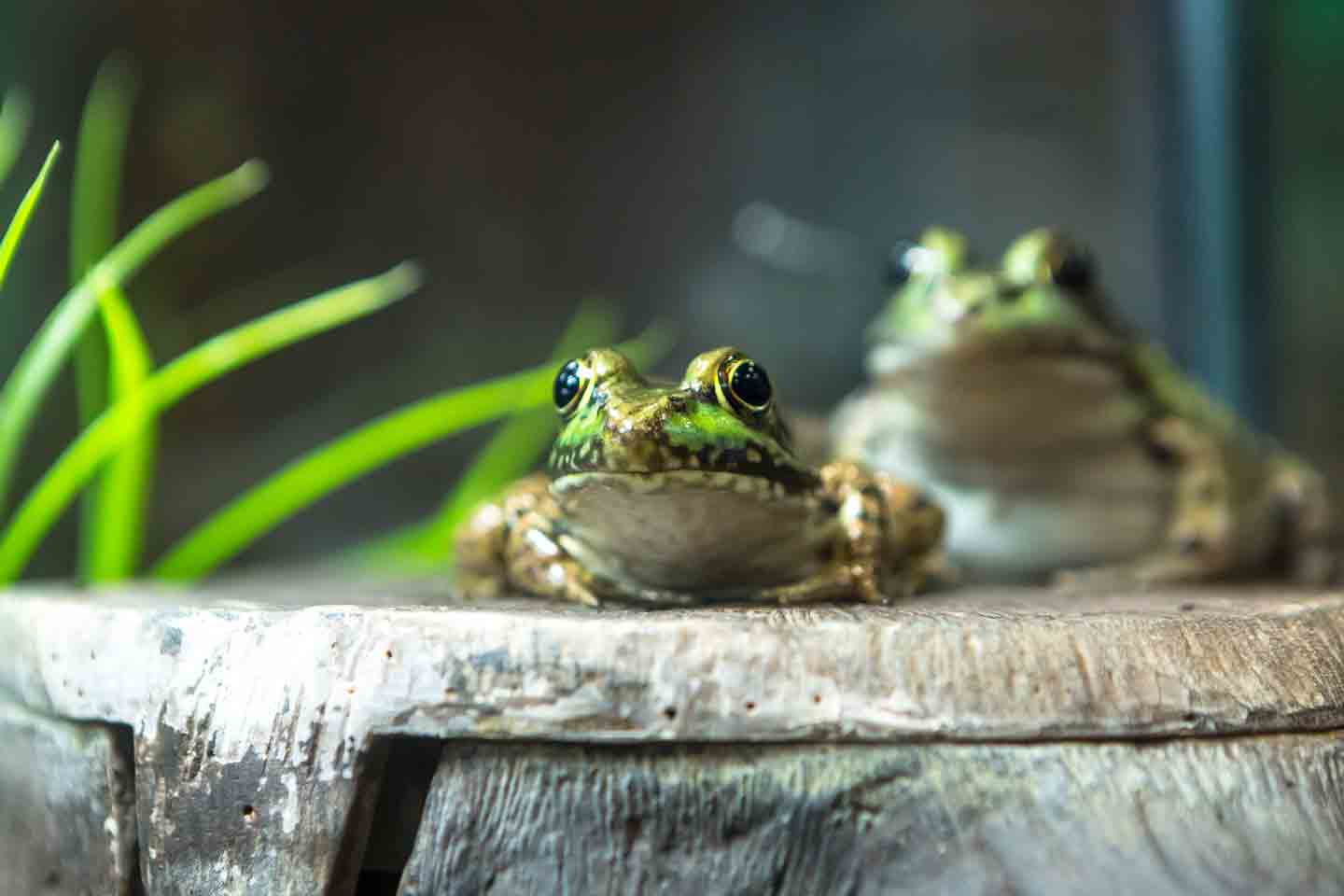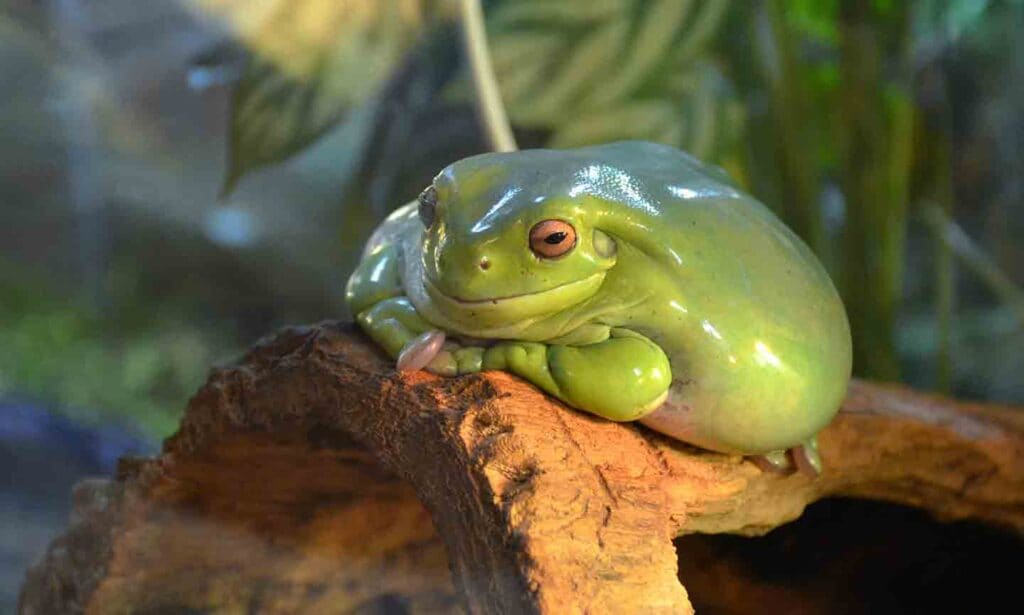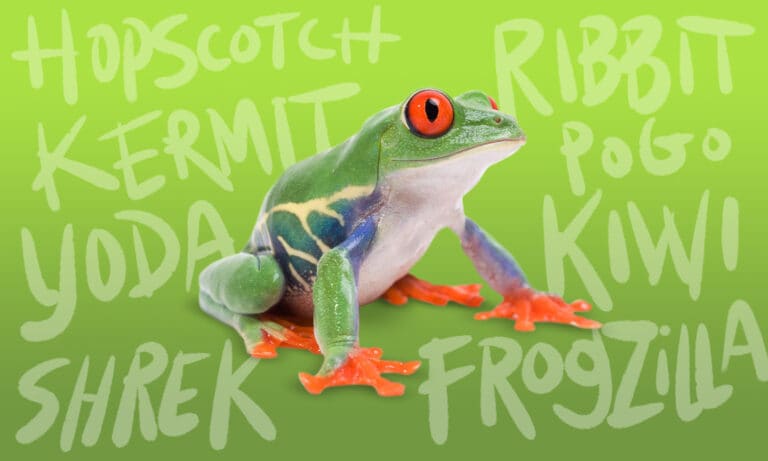In This Guide:
New Frog Tank Checklist
According to Smith, there are more than 7,000 species of anurans (that’s the scientific order that includes frogs and toads), including dart frogs, red-eyed tree frogs, tree frogs, White’s tree frogs, green tree frogs, bullfrogs, pixie frogs, and literally thousands more. With so many different frog species, your frog tank setup might differ from another’s, based on the specific needs of your frog. However, there are a few general rules to consider.
We’ve listed everything beginners need for a frog tank setup, including specific products, what they do, why they’re needed, and everything else a frog keeper should know.
- Tank
- Substrate
- Hideouts/retreats
- Water conditioner
- Water dish
- Lighting
- Heating
- Water test kit (for aquatic frogs)
- Filter (for aquatic frogs)
- Thermometer
- Hygrometer
- Spray bottle or misting system
- Decor and accessories
Tank
You may have heard about different types of frog enclosures, such as terrariums, vivariums, and paludariums—but, according to Smith, they all contain most of the same elements. Though their definitions vary slightly, Smith explains that each term technically describes an acceptable frog habitat.
- A terrarium is an aquarium that acts as a mini ecosystem. “It will contain a more naturalistic setup of live plants and natural substrates to mimic the environment of the species being maintained. Some people would say this could be either desert, subtropical, tropical, or temperate,” Smith says.
- Paludariums are terrariums with an added wetland or water feature.
- A vivarium is any enclosure or structure with living things in semi-natural conditions. Both terrariums and paludariums are types of vivariums. You might also hear vivariums referred to as bioactive enclosures.
The type of tank your frog needs will depend on their species. Ask your vet if you’re not sure which is best for you.
Another feature to consider is the size and orientation of your frog’s tank.
“If you are working with a tropical, arboreal tree frog, then a vertically oriented setup is best,” Smith explains, to allow your frog to climb just as they would in the wild. For terrestrial species, meaning frogs that spend most of their time on the ground, “providing more surface area on the ground is appropriate. For mostly terrestrial species [that] may like to climb—like many of the commonly kept and bred poison arrow frogs—it’s best to provide a combination of the two.”
As a general rule, Smith adds, “It’s best to provide them with as much choice as possible, to provide a diverse environment so they can climb and hide as needed.”
Substrate
Substrate refers to the material that lines the floor of your frog’s enclosure. This could be aquarium gravel, sand, or coconut fiber. Again, the best option for your frog will depend on their species.
According to Dr. Hess, most frog tank setups should contain multiple layers of substrate for drainage and to recreate the frog’s natural environment.
The bottom layer, she says, should be made up of non-absorbent gravel or clay. Above that layer, place a screen to prevent the top layer of substrate from settling into the sand or gravel. Finally, use an organic layer such as leaf litter or moss on top.
“That way, excess water drains to the bottom of the tank instead of being absorbed by the organic layer,” Dr. Hess adds.
Hideouts and Retreats
The best frog tank setups closely reflect a frog’s true environment in the wild. While it depends on the frog species, all natural habitats contain spots for frogs to hide from predators. In vivariums, these are called hideouts, hides, or retreats.
“Hides can be anything from bark, branches, logs, and leaf litter—or they can be larger items built into the habitat,” Smith says. “Many people like to use coconut shells or similar natural items.”
Water Accessories
Most frogs require dechlorinated water only. That means you’ll need to treat your tap water with a water conditioner to remove chlorine and other dangerous elements. Don’t use distilled or reverse osmosis water, Dr. Hess says, “because that can take minerals out of the tank.”
Frogs and their enclosures should be kept moist and humid at all times, which is why many frog keepers leave a spray bottle of dechlorinated water nearby or invest in an automated misting system.
If you have an aquatic frog, you’ll need a water quality testing kit, Dr. Hess says. This will allow you to monitor your frog’s water quality and take action if the water parameters fall outside of what’s recommended for your frog’s species.
“It should be the appropriate water chemistry and quality for the species,” Smith explains. “Some species prefer higher or lower pH, some have other needs for the hardness, alkalinity, etc.”
“You should also always monitor humidity with what’s called a hydrometer or hygrometer,” Dr. Hess explains. “It tells you what the humidity in the tank is as well as measuring temperature. You should stay within the humidity and temperature range of that specific species, as some are warmer or cooler depending on the species.”
Frogs should also have access to a clean water dish of dechlorinated water, which should be large enough for them to fit in and soak themselves. Frogs typically defecate in water, so clean and refill the water dish daily.
Lighting
Frogs, amphibians, and other reptiles typically do well in ultraviolet B, or UVB, lighting, a specific type of ultraviolet lighting. UVB lighting helps frogs produce more vitamin D, which is crucial in regulating their calcium absorption.
“Lighting should be evaluated and tested for your species,” Smith explains. “The Ferguson scale—which developed multiple zones for different species of reptiles based upon research evaluating what UV requirements [each species] needs—can be used as a guide to start. This helps keepers test the zone for their species to ensure they are meeting the UV needs. But your lighting should be appropriate and tested, then replaced as the UV degrades over time. Too much or too little UV can cause health issues, sometimes severe or fatal.” UV bulbs will need to be replaced regularly, because they can stop emitting UV even though they still show light.
Heating
Frog keepers should also use a thermometer to keep track of the tank’s temperature.
“Temperature controls can be accomplished in a variety of ways, so you should pay close attention to the ambient temperature of the room to start,” Smith explains. “There are many options for heaters and chillers, but make sure whatever you are using is safe for the environment and be sure to follow the instructions/guidelines appropriately.”
Filter
“A filter is only necessary for frogs that are purely aquatic, such as African dwarf frogs or African clawed frogs,” explains Dr. Hess. “These frogs need a low-flow filter to keep the water clean but [won’t] disturb them too much. You want roughly two to five water changes per hour.”
For example, if there are 10 gallons of water in the tank, the filter should have a flow rate of 20-50 gallons per hour.
Dr. Hess continues, “Most non-aquatic frogs should be kept with a small bowl or basin of water that is cleaned/replaced daily or every other day. As a result, these frogs do not require a filter. If owners decide to make a large aquatic part of their frog cage, which would not be practical to be changed daily, then a filter would be required.”
How To Set Up Your New Frog Tank

Once you have all your frog tank setup essentials, you’re ready to prepare your pet frog’s beautiful new home.
1Wash Your Gear
“Disinfect everything that you can,” Smith suggests. “I would typically suggest a light bleach solution to use along with a soak and scrub.” Afterward, rinse everything well to ensure there are no chemical residues. “I would also suggest a final rinse with your conditioned”—meaning dechlorinated—“water,” Smith adds.
As for the water-to-bleach ratio, Smith suggests referencing a trusted source to find out the appropriate levels of each. “This is a tricky one because not all bleach is the same, and concentrations and contact times are important.”
2Add Substrate to Your Tank
Now it’s time to create your layers of substrate. Start with non-absorbent sand or gravel, then place a screen on top of that, and then top it off with your organic substrate, such as leaf litter or moss.
3Install Non-Electric Accessories
Add all of your non-electric accessories to the frog tank setup, including hideouts and retreats and artificial plants.
4Add Water
First condition your water according to the directions on your water conditioner, then test it using your water quality kit. When you’ve determined its levels are appropriate for your frog’s species, add it to the tank.
Keep extra conditioned water on hand for tank maintenance, misting, and to replace water that has evaporated, Smith recommends.
5Install Electronic Accessories
Electronic accessories include lighting, heating, timers, filters, and/or misting systems. Installment will vary depending on the brand and type, so follow the maker’s instructions.
6Monitor the Conditions
“You want to set the environment up first, then let it settle,” Dr. Hess says. “Let the vivarium come to stability before you put your new pet in.”
While the frog enclosure settles, monitor every aspect.
“Check the parameters of everything from your water to your lights and give your tank a good ‘sniff test’ to ensure it has a nice, organic, earthy smell,” Smith adds. “This is to ensure the substrate is mixed and managed appropriately.”
7Introduce Your Frog
Dr. Hess reminds frog keepers to never handle frogs with their bare hands. Use latex gloves moistened with dechlorinated water to pick up and move them.
Once in the frog enclosure, “Give the frog time to adjust,” Dr. Hess says. “You don’t want to bombard them with a lot of food when they first get in. Letting them acclimate is very important and can take a few days.”
In those first few hours and days after introduction, Smith says, “There will be lots of hiding and lots of exploring. Give them time,” he adds, “but start watching and learning behaviors, as this will help [you] better understand their needs over time. Ensure they are comfortable with the environment and where you are feeding them. Move slowly when working around them to ensure you aren’t creating extra stress.”
When monitoring your frog, check for signs of good health:
- A bright color
- Shiny skin
- Activity/moving around their enclosure
- A healthy appetite
“If they look kind of pale or if their skin looks kind of dull, that can mean they’re not feeling well or they’re dehydrated,” Dr. Hess says. “Frogs should also be active and moving around—and, of course, if they’re not eating, that’s a bad sign.”
How To Clean Your Frog Tank
Cleaning the frog tank is another crucial part of maintaining the health of your pet, and your cleaning routine will differ depending on the frog species as well as the type of frog tank setup you have.
“Remember that anything you put in the tank can be absorbed by the skin,” Dr. Hess explains. “Use dechlorinated water to flush out and change the filter. Spot-clean every day, taking out the food that hasn’t been eaten and removing fecal material.”
How To Clean the Filter
Aquatic frogs will require a filter, which should be carefully cleaned once or twice a month depending on use and buildup. There are different kinds of filters with parts that may require different kinds of cleaning: mechanical filters, biological filters, and chemical filters. All three are appropriate for your aquatic frog; it just depends on which one(s) you prefer, how much money you want to spend, and so on.
“Filters will have different parts depending on how advanced they are,” says Dr. Hess. “Most filters will have two or three chambers for filtration. The mechanical filter (which consists of a mesh, which physically filters out large chunks/debris), should be rinsed out using water from the tank. The idea is to clean off those chunks without eliminating the beneficial bacteria that grows on this filter and is present in the water. The biological filter—usually a solid white sponge—should also be cleaned out in the same way.”
If you have a chemical filter, which according to Dr. Hess is “usually a cartridge that contains activated charcoal or another carbon-based material that pulls toxins out of the water,” then it should be replaced, and the rest of the filter parts should be cleaned without soap. “The solid parts of the filter (impeller, tubing, etc.) can be cleaned and rinsed off in tap water. Soap should NOT be used.”
How To Clean Aquarium Decor
According to Dr. Hess, you’ll need to clean aquarium decor whenever it is soiled—or at least once a month.
“The type of cleaning depends on the type of decor—hard plastic, stone, and even wood can be cleaned with Dawn dish soap and water,” Dr. Hess says. Just make sure the soap is fully rinsed off before returning it to the habitat. “Do not use exotic soaps such as those containing essential oils, as these can be very toxic to amphibians. Live plants usually do not need to be cleaned.”
How To Clean the Substrate
Bioactive terrariums—completely natural, self-sustaining habitats with microorganisms present in the soil—“are nice because the substrate usually does not need to be changed or cleaned, as it takes care of itself,” Dr. Hess explains. “Otherwise, the substrate should be changed weekly to monthly, depending on how soiled it gets.”
With most tank environments, you should be changing out the substrate at least once a month. Take everything out of the tank, including the decor, and use a turkey baster of water to clean out corners and behind rocks. It’s OK to leave some substrate behind; just be sure to spot-clean frog feces and slime using a wet paper towel and, according to Smith, a light bleach solution (see “Wash Your Gear” above). “Follow up with thorough flushing to ensure chemicals are no longer present, much like the initial cleaning before set up,” Smith adds.
Once weekly, sift the substrate with a rake or other tool, and when it’s time to clean the substrate—about once a month or every other week, depending on how soiled it gets—make sure to wash it out really well. “You don’t want any residual chemicals to potentially dissolve in the dechlorinated water you put back in the tank, and then be absorbed by their skin,” Dr. Hess adds.
FAQs About Frog Tank Set Up
Q:Do frogs need land in their tank?
A:“It depends on the species,” explains Smith. “There are a number of completely aquatic species that don’t need land; however, many species of frogs only need water for breeding, so they spend most of their time on land.”
Q:What do you put at the bottom of a frog tank?
A:“For tropical setups, I would use a ‘false bottom’ or similar setup to allow for drainage,” explains Smith, who also recommends using gravel of various sizes. “Then, an organic mix substrate to create a bioactive substrate. If it were a desert/arid theme, I would use a safe sand substrate.”
Q:What do African dwarf frogs eat?
A:“Almost anything that will fit into their mouth, if they can catch it,” says Smith. “Upon acquiring [your frog], they can be picky, but ask the breeder/source what they are currently eating and try to duplicate that if it makes sense and is nutritious.” Smith adds, “Then, as possible, offer a variety of live and/or frozen and freeze-dried foods for diversity and nutrition.” Smith mentions bloodworms, white worms and blackworms as options.
Q:What size tank is recommended for a pair of Pacman frogs?
A:“I would suggest the largest that you are able to provide and focus on providing as much surface area as possible for this species,” Smith says. However, Smith suggests Pacman frog owners proceed with caution. While it is possible to house two Pacmans together, many herpetologists dissuade cohabitation. “Many people don’t maintain them together out of fear of the frogs trying to eat one another,” says Smith, adding that Pacman frogs eat anything that fits in their mouth (including other Pacman frogs).
Knowing how to house your frog is the first step toward providing a happy, healthy life for your pet. The next step: Learning what your frog should eat.
Expert input provided by Laurie Hess, DVM, senior exotic animal veterinarian at Veterinary Center for Birds & Exotics in Bedford, New York; and Dustin Smith, curator of herpetology, fish, and invertebrates at the North Carolina Zoo in Asheboro, North Carolina.
This content was medically reviewed by Chewy vets.
Caring for Frogs
Share:























